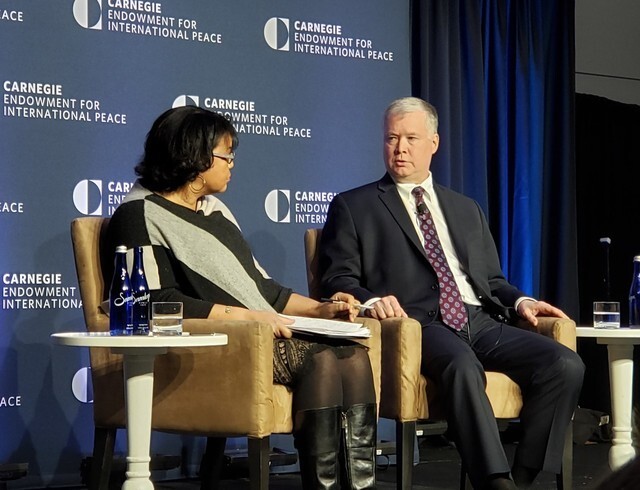hankyoreh
Links to other country sites 다른 나라 사이트 링크
[Editorial] Current path of US is only going to make denuclearization negotiations harder

On Mar. 11, US State Department Special Representative for North Korea Stephen Biegun stated that the US would not take an incremental approach to North Korea’s denuclearization and called for a total solution. Biegun also said that US President Donald Trump had made that position clear and that US officials had completely fallen in line. In effect, the US has officially endorsed an all-or-nothing deal as its approach to the North Korea-US denuclearization talks. That’s vastly at odds with North Korea’s step-by-step approach to denuclearization, which is cause to worry that the standoff between the two sides will become prolonged.
What the US wants from North Korea in the process of denuclearization, Biegun said on Monday, is the elimination of all elements of its nuclear fuel cycle and nuclear weapons program. Biegun’s remarks in a public venue mean that even the leading advocate of dialogue in the Trump administration has gotten on board with the all-or-nothing approach. The US administration appears to be aligning behind that approach, which Trump elaborated during the North Korea-US summit in Hanoi. This downsizing of the pro-dialogue contingent is likely to make it even harder for North Korea and the US to reach a deal.
Of course, we shouldn’t jump to the conclusion that there’s no more chance of a breakthrough between the two sides. If the US’ all-in-one plan means moving forward in stages after settling on an overall roadmap for denuclearization, there may still be a way to reach a solution through negotiations with North Korea. But if the US’ plan means lifting sanctions after the North simultaneously destroys its nuclear facilities, materials and weapons, a deal becomes very unlikely indeed.
What’s fortunate is that, even after the US pivoted to an all-in-one solution, North Korea’s position has not changed. Even on Mar. 12, the North Korean media stated that the North’s “firm position is moving toward complete denuclearization.” That was the first time the North had voiced its support for “complete denuclearization” since the collapse of the Hanoi talks. That can be taken as representing the strength of North Korea’s commitment to finding a solution through dialogue. Biegun also said that Trump is ready to meet North Korean leader Kim Jong-un once again. But since such a meeting would be predicated on the North accepting an all-inclusive deal, that basically means that negotiators will have a hard row to hoe moving forward.
One of the major reasons for the Trump administration’s transition to an all-in-one deal appears to have been pressure from the US political establishment. But given the continuing distrust between North Korea and the US, a forceful “all or nothing” strategy is likely to be counterproductive. While holding to the principle of complete denuclearization, the Trump administration needs to explore a variety of practical ways to narrow the gap between the two sides. Continuing along the current path is likely to just make it harder to reach the goal of completing denuclearization before the end of Trump’s term.
Please direct comments or questions to [english@hani.co.kr]

Editorial・opinion
![[Editorial] Penalties for airing allegations against Korea’s first lady endanger free press [Editorial] Penalties for airing allegations against Korea’s first lady endanger free press](https://flexible.img.hani.co.kr/flexible/normal/500/300/imgdb/original/2024/0502/1817146398095106.jpg) [Editorial] Penalties for airing allegations against Korea’s first lady endanger free press
[Editorial] Penalties for airing allegations against Korea’s first lady endanger free press![[Editorial] Yoon must halt procurement of SM-3 interceptor missiles [Editorial] Yoon must halt procurement of SM-3 interceptor missiles](https://flexible.img.hani.co.kr/flexible/normal/500/300/imgdb/child/2024/0501/17145495551605_1717145495195344.jpg) [Editorial] Yoon must halt procurement of SM-3 interceptor missiles
[Editorial] Yoon must halt procurement of SM-3 interceptor missiles- [Guest essay] Maybe Korea’s rapid population decline is an opportunity, not a crisis
- [Column] Can Yoon steer diplomacy with Russia, China back on track?
- [Column] Season 2 of special prosecutor probe may be coming to Korea soon
- [Column] Park Geun-hye déjà vu in Yoon Suk-yeol
- [Editorial] New weight of N. Korea’s nuclear threats makes dialogue all the more urgent
- [Guest essay] The real reason Korea’s new right wants to dub Rhee a founding father
- [Column] ‘Choson’: Is it time we start referring to N. Korea in its own terms?
- [Editorial] Japan’s rewriting of history with Korea has gone too far
Most viewed articles
- 160% of young Koreans see no need to have kids after marriage
- 2Presidential office warns of veto in response to opposition passing special counsel probe act
- 3[Editorial] Penalties for airing allegations against Korea’s first lady endanger free press
- 4Hybe-Ador dispute shines light on pervasive issues behind K-pop’s tidy facade
- 5S. Korea “monitoring developments” after report of secret Chinese police station in Seoul
- 6Months and months of overdue wages are pushing migrant workers in Korea into debt
- 7OECD upgrades Korea’s growth forecast from 2.2% to 2.6%
- 8Inside the law for a special counsel probe over a Korean Marine’s death
- 9Japan says it’s not pressuring Naver to sell Line, but Korean insiders say otherwise
- 10[Exclusive] Hanshin University deported 22 Uzbeks in manner that felt like abduction, students say